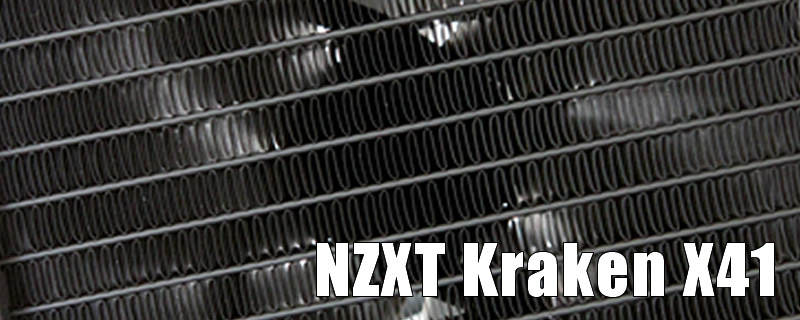NZXT Kraken X41 Review
Conclusion
It’s fair to say that competition is hotting up in the AIO cooler world. It wasn’t too long ago that the now common place AIO didn’t even exist, with the only way into better cooling being via esoteric custom loops. Not today though, now you can strap on an AIO and clock the twangers off your CPU secure in the knowledge that for the greater part only your own stupidity rather than escalating temps caused by unreliable and inefficient cooling will cause things to fry.
Unlike other manufacturers who either favour the 120mm fan based systems or who produce a range of 120mm and 140mm solutions, NZXT have fallen firmly on the side of the 140mm fan based set ups. The original X40 itself a 140mm rad based AIO was released back in late 2012, taking part in a multi-vendor showdown here at OC3D and earning itself a Silver award. Since then the world has moved on and it’s been necessary for NZXT to refresh their line up and offer something new and exciting to us, the discerning public.Â
The X41 then is the successor to the X40, but is to all intents and purposes a totally different beast. It’s 26% thicker for a start which as we’ve seen from the torture tests does enable it to leave the older X40 standing. It also has longer high flexibility tubing which will enable the placing of the radiator in places that might not otherwise have been an option. Longer tubing isn’t necessarily a good thing though, as too much can lead to problems with fouling or even just make the job of working out what to do with it all as it coils and curves its way from cold plate to Rad a right royal pain in the buttocks. At 400mm though NZXT seem to have it just about right. They’ve also kept their thinking caps on when it comes to the cables which emerge from the cold plate, and boy are there a lot of them, with all those that look to require long lengths being granted long lengths, as an example, the 3pin pump cable which is intended to be plugged into the motherboard CPU fan header is kept nice and short as a long run would be unnecessary, while the USB cable is good and long enabling to be routed and kept tidy round the back of the motherboard while still having enough slack to make it to the connection on the board.
The build quality of the Kraken X41 is more than acceptable, with no evidence of damage to the fins and tubing found. The unit looks well-built and well presented in its striking red black and white packaging. A good selection of fittings for both Intel and AMD are included taking you all the way to when Adam was a lad, (well almost, there’s no 775 in there). Whether you choose to mount on AMD or Intel the method is much the same and is simplicity itself.  OK, so the instructions aren’t great, some of the worst we’ve ever seen in fact, but there is a link to an online animation of the various processes which are excellent and enable NZXT to claw some points back.
While on line it’s also worth downloading the free CAM software. While not strictly necessary for the basic operation of the X41 it does open up a world of local or cloud based monitoring and control, enabling the user to set custom fan profiles, monitor hardware performance, as well as changing the colour and mode of RGB LED lighting of the cold plate assembly. NZXT also make something of a fanfare of the Kraken X41 being the first AIO to have a variable speed pump. Now while this might be a great marketing tool, we’re not entirely convinced of its real world applications and benefit, especially as it doesn’t appear to have any sort of manual mode. Our experience of AIO coolers thus far has been that the fan noise has for the most part obscured the noise from the pump, (the notable exception being the Eisberg range of AIOs whose pumps were so loud they made your ears bleed). In use the pump speed on the X41 only seemed to drop 800 RPM or so down from its maximum, with noise levels not really seeming to alter discernibly, and at all times being lower than the noise from the fans.
The biggest failing though of the X41 is that it really didn’t perform as well as we’d have hoped. Yes it trounces the older X40, but when push comes to shove it’s outpaced by the smaller 120mm rad based push pull set up of the H80i which is just the sort of comparable set up that NZXT claim it’s 36% larger surface area should beat. It’s also beaten by a small margin by the similarly sized and Nepton 140XL granted this is a twin 140mm fan model, but it does come in at the same price point as the X41. Most disappointing of all though, and to rub salt into the wounds of defeat is that at 4.4GHz it’s beaten by a good old fashioned tower CPU cooler in the form of the Noctua NH-D15, which at just £77 is a good bit cheaper than the X41.
So the X41 might not have it in pure performance stakes, but if you read the full review, or even take away and balance the positives and negatives from the conclusion you’ll realise that it does present a reasonable overall picture. For a start, neither the Nepton 140XL nor the NH-D15 can be used with the G10 GPU cooler bracket, and few of the other coolers in the charts offer the degree of control and monitoring permitted by the X41 when paired with the free CAM software. It’s also one of the few that offer a long enough lengths of tubing and cabling to enable the rad to be placed in a greater variety of places in the case than would otherwise have been possible.
But does it get a Gold? No, we’re afraid it doesn’t, only the very best get that accolade and while the X41 is definitely a good cooler, all things considered it isn’t a chart topper.Â
Thanks to NZXT for the sending in the X41 for review, you can discuss your thoughts in the OC3D Forums.




